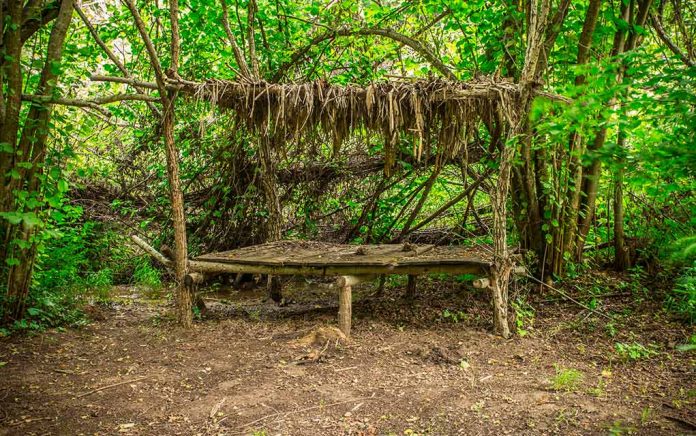(SurvivalDaily.com) – In almost any survival situation, shelter is going to be your top priority. The climate can kill us in a whole range of ways – in as little as three hours of exposure. From dehydration and heat exhaustion to hypothermia, nature has a variety of deadly options to choose from.
The only way to avoid an untimely death from exposure to the elements is to put a barrier between ourselves and Mother Nature. Unfortunately, unless you carry a four-season tent everywhere you go, that’s probably going to need some improvisation.
Short-Term Shelter — Block the Sun and Wind
Deserts are some of the hardest environments in which to find shelter. If there are plants, use them as shade; otherwise, you might have to improvise shelter using your clothing. Clothes set up as a canopy will provide some shade, and that’s more effective at keeping the sun off than wearing them.
Wind is a potential killer in almost any climate. If you want to get out of the wind, look carefully at the ground. Even a gentle dip can protect you from the worst of it. Fallen trees are also good. Look for barriers with small plants and flowers growing on one side of them; that’s likely to be the more sheltered side.
Stay Dry
Keeping the rain from soaking you is a harder task. If you have a tarp or some plastic sheets — even a few garbage sacks — it’s easy enough to improvise a waterproof canopy, but making one from natural materials takes some work.
In the short-term, trees can give reasonable protection from rain. If you look under some fir trees you’ll see that the carpet of dead needles stays dry in almost any weather — get underneath, and you will, too. Some conifers with low-hanging branches are almost perfect ready-made shelters.
If you have to build a shelter, debris is your friend. Any kind of plastic sheet is a great material, and even small pieces can be fixed to a frame and overlapped to give good waterproofing. You can lash thin, straight branches together into a grid to make the frame of your shelter. Then fasten pieces of plastic to it (use sap, mud, or even threads torn from clothing to make this happen). Do this in rows, starting at the bottom; overlap each piece in a row slightly, and then when you start the next row, overlap it on the one below. This way, water running down your shelter will always flow onto the next row down.
If you can’t find plastic, you can get the same effect with many natural materials. Animal skins make great shelter material if you have them. If not, you can use leafy branches, bundles of long grass, sheets of bark peeled from a tree or even slabs of turf (make sure to use a sturdy frame if you choose turf, it’s heavy). Again, overlap layers starting at the bottom.
Shelter building is an essential survival skill, and is one you should practice whenever you can. That way you’ll discover the common pitfalls before your life depends on avoiding them. For example, what’s the right angle for a shelter roof? If it’s too shallow you’ll get more leaks. If it’s too steep you risk wind damage.
Also, make sure you have the basic tools — cord and a good knife — in your outdoor gear. Do that, and you’ll be able to stay out of the weather wherever you are.
Do you have any survival shelter tips you would like to share? Reply to your email and let us know, we would love to hear from you!
Copyright 2021, SurvivalDaily.com

















